
http://www.iaeme.com/IJM/index.asp 370 editor@iaeme.com
International Journal of Management (IJM)
Volume 7, Issue 7, November–December 2016, pp.370–381, Article ID: IJM_07_07_041
Available online at
http://www.iaeme.com/ijm/issues.asp?JType=IJM&VType=7&IType=7
Journal Impact Factor (2016): 8.1920 (Calculated by GISI) www.jifactor.com
ISSN Print: 0976-6502 and ISSN Online: 0976-6510
© IAEME Publication
CONSTRUCTION PROJECT MANAGEMENT DURING
ECONOMIC CRISIS
Sumesh Sudheer Babu
Research Scholar, Department of Management,
Bharathiar University, Coimbatore, Tamilnadu, India
Dr. B. Sudhakar
CEO &Director, Wisdom School of Management,
Pollachi, Tamilnadu, India
ABSTRACT
Negative events in today’s globalized world may lead to crises and thereby affect construction
companies in time gradually. These events may occur suddenly or after a long process. Process-
based crises usually send early warning signals, and construction companies that can catch these
signals can prepare against the forthcoming crises. One of the most important processes in crisis
management is to establish an early warning system. This provides some time to take the required
precautions against potential crises. After catching early warning signals, construction companies
that can successfully manage crises inform their personnel about approaching crisis to prepare,
organize a crisis team before the crisis, and perform an effective struggle during the crisis.
Construction companies, which can survive in a crisis, may evaluate opportunities of the crisis and
start to make recovery studies after the crisis to turn to their former positions. If a construction
company estimates a crisis well and executes crisis management efficiently, they can overcome
crises with zero or minimal damage.
Key words: Construction, Project Management; Economic Crisis, National Crisis
Cite this Article: Sumesh Sudheer Babu and Dr. B. Sudhakar, Construction Project Management
During Economic Crisis. International Journal of Management, 7(7), 2016, pp. 371–381.
http://www.iaeme.com/IJM/issues.asp?JType=IJM&VType=7&IType=7
1. INTRODUCTION
A crisis is a situation faced by an individual, a group or an organization, which they are unable to cope
with, by the use of normal routine procedures and in which stress is created by sudden change [9].Crisis
may come in various forms. It can be result of wrong management decision, economic slowdown or
recession influencing the industry or organization. The recent large-scale global economic recession
attracts analyses often from a macroeconomic perspective. Within this context, the terms “crisis” and
“change” are now what the companies are to be dealt with. Both situations bring about uncertainty that led
the companies to search for new strategies in order to sustain those uncertainties. Construction firms that
can successfully manage a crisis can quit it with a minimum loss and can expand their market shares after

Construction Project Management During Economic Crisis
http://www.iaeme.com/IJM/index.asp 371 editor@iaeme.com
the crisis. In other words, firms that can escape from a crisis with zero or minimum damage may
strategically have competitive advantages over existing rivals. This paper explores the results of research
conducted using questionnaire survey conducted over sample of construction companies operating at oil
field sector in Abu Dhabi, which are suffering from recession caused by low oil prices. The quantitative
and qualitative data obtained from an expert survey reveal significant changes in the management of
construction projects subject to the economic crisis. In addition, this study attempts to reveal both
innovative crisis management approaches and the corresponding process that helps to manage crises better
and turn to their former positions in the short term through innovation-based means. In fact, this is a virgin
area in the construction management literature and thus can contribute to the creative and innovative
management of companies under potential crises in micro and macro levels. Construction companies
should learn crisis and crisis management concepts to escape from crises. Therefore, in this study, key
points such as the concept, properties, objectives, approaches, and the process of crisis management was
explained in a detailed manner from the perspective of the construction industry to increase performances
of construction companies during crises. Thus, the current study can contribute to construction companies
to catch early warning signals of a crisis, to motivate the personnel against the crisis, to perform an
effective struggle during the crisis, and to turn to the former position in a short time after the crisis.
2. LITERATURE REVIEW
In the construction management literature, there are a dozen of research studies concerning crisis
management. However, these are far from investigating management practices of construction companies
in the crisis process. In fact, they are specifically about theory formulation, contractual conditions,
environmental and organizational factors [5], organizational behaviour, preparedness [4], social
adjustment, and social network analysis. The topic of this study is an intersection between a number of
themes such as project success, crisis management and project context. The following literature review
formulates the basis of this research.
From a language point of view, a crisis means "a time of intense difficulty or danger" [14] or "a
situation that has reached an extremely difficult or dangerous point; a time of great disagreement,
uncertainty or suffering" [15]. In a more technical definition, a crisis is a situation faced by an individual,
group or organization in which it is not possible to cope by the use of normal routine and procedures, and
in which stress is created by sudden change [9]. The crisis is described as a period of sudden change during
which a totally new system is formed. In fact, the meaning of a crisis includes opportunity as well as risk,
uncertainty, threat, conflict, accident etc. The crisis can have specific meaning depending on its context, as
in the case of economic crisis and industrial crisis, for example. This study is concerned with national
crises. A national crisis is defined as “a situation or time at which a nation faces intense difficulty,
uncertainty, danger or serious threat to people and national systems and organizations and a need for non-
routine rules and procedures emerge accompanied with urgency. Because crises are in general unwanted
events with serious consequences, there is a need to deal with their impact; thus, crisis management has
evolved.
In the construction management literature, there are a dozen of research studies concerning crisis
management [2].Crisis management is a process and management model applied in extra-ordinary
situations. It includes particular activities such as detecting crisis signals, preventing its possible negative
effects on construction firms, surviving with a minimum loss, and applying and controlling preparation
activities for recovery. The aim of crisis management is not to try to prevent crises absolutely, but to
minimize negative results, to have quick and high quality responses, and to prepare against all types of
crises as much as possible. Construction companies can easily be affected by a crisis because initial
investment costs are quite high in construction projects and thus may lead to huge financial damages.
Therefore, construction companies should analyse the internal and external environment constantly, catch
early warning signals to be ready against crises, and perform an effective struggle during a crisis for their
survival. Crisis management that should be applied in construction companies has some specific
characteristics that differ from the traditional management approach. These are listed below.

Sumesh Sudheer Babu and Dr. B. Sudhakar
http://www.iaeme.com/IJM/index.asp 372 editor@iaeme.com
• Such companies that can manage crises can estimate crises and distinguish them by their types, take
preventive measures, learn lessons, and recover as soon as possible.
• Managers and employees are flexible, creative, objective, courageous, decisive, patient, strong mentally,
sensitive, self-sacrificing, team members, active, open for innovation, and ready against unknown or
undesirable events in unexpected times.
• Some factors (i.e., communication, audit, business culture, and planning) have utmost importance.
• Crisis management is a continuous process that includes normal times, which provides to be always
ready against crises.
In practice, construction companies can use five (5) different approaches to prevent crises.
Figure 1 Crisis management approaches
The Escaping Approach
In this approach, it is necessary to follow the internal and external environment constantly and improve
prediction methods about the future before a crisis. In order to prevent negative effects of crises, top
management should determine the needs and key values of the construction company to establish the
projected objectives. It is also essential for top management to inform personnel about the policy, share the
values, and transfer its philosophy. Moreover, it is a prerequisite to identify problems, find effective
solutions, and establish a flexible, dynamic, and enthusiastic company structure for easy practices [5].
Especially, catching early signals that indicate negative macroeconomic conditions (inflation rate, interest
rate, unemployment rate, etc.), dramatic variations in the foreign currency and political/international crises
may provide insights about investment decisions to be made.
The Escaping
Approach
Crisis Management
Approaches
The Solving
Approach
The Proactive
Approach
The Reactive
Approach
The Interactive
Approach
•
Providing correct and adequate
information
• Determining risks
• Establishing early warning systems
• Making a prevention plan
• Forming a crisis prevention team
•
Shrinkage
• Closing some departments
• Deduction in salaries
• Unpaid vacation
• Restriction in overtime
• Dismissal

Construction Project Management During Economic Crisis
http://www.iaeme.com/IJM/index.asp 373 editor@iaeme.com
The Solving Approach
This approach depends both on the prediction of conditions before a crisis and on a timely move for the
problem resolution during a crisis. During a crisis, current conditions should be perceived and identified
clearly and behaved in a realistic and patient manner. In addition, some efforts such as the systematic
compilation of information for effective decisions, extra opportunities for staff in different levels, the
reduction of the time pressure, and the detailed identification of sources of a crisis should be made.
Construction companies should take into account the following criteria to take advantage during a crisis,
• A crisis can also bring opportunities.
• Competition strategies should be determined exactly.
• Strengths in the strategic competition should be analysed deeply.
• Internal savings should be paid attention.
• Investments that can provide a high financial return in the short term should be given priority.
• Personnel should be motivated against crises.
• Competitors and changes in real estate and construction markets should be followed.
• The customer satisfaction should be the main philosophy.
• Long-term investments should be refrained.
• Advertisement and promotion activities should be performed.
• Qualified labour should be preferred.
• Defensive strategies should be followed.
• Costs should be decreased instead of the amount of production.
• Trading activities should be based on cash instead of the amount of sales.
Besides these criteria, construction companies can analyse strengths, weaknesses, opportunities, and
threats (SWOT), and make strategies during a crisis according to their strengths to turn it to an opportunity.
The Proactive Approach
According to this protective approach, top management should produce alternative solutions against
potential crises. Because of preventive measures, construction companies that can adapt their production
and marketing activities to crisis conditions can financially be successful while their competitors are in a
panic. For developing such an approach, items presented below should be fulfilled,
• Providing correct and adequate information,
• Determining risks,
• Establishing early warning systems,
• Making a prevention plan,
• Forming a crisis prevention team.
The Reactive Approach
This restoring approach can be chosen by top managers or suitable for construction companies in an
unexpected crisis. Such companies usually make aggressive decisions by means of an immediate meeting
of board of directors during the crisis. In general, short-term measures in these decisions are
• Shrinkage,
• Closing some departments,

Sumesh Sudheer Babu and Dr. B. Sudhakar
http://www.iaeme.com/IJM/index.asp 374 editor@iaeme.com
• Deduction in salaries,
• Unpaid vacation,
• Restriction in extra services,
• Dismissal.
By these measures, however, they may lose the trust of personnel, experienced employees, and
customers. The reactive crisis management is the most risky approach, among others. Although it can be
adequate to overcome small-scale and short-term crises, it is an unsuccessful method in the struggle with
large-scale and middle-/long-term crises. This is because construction companies, which are not ready
against potential crises, have considerably limited abilities.
The Interactive Approach
This integrated approach evaluates the crisis process before, during, and after the crisis. Because of the
information obtained in this process, it includes the continuous organizational learning and self-control
mechanism. A permanent communication and information flow is provided for the benefit and reputation
of all stakeholders. Construction companies that are willing to apply this approach should be clear, share
the effects of the crisis with their stakeholders honestly, and determine a common policy against the crisis.
The contribution of stakeholders can be helpful in the survival of these companies.
2.1. THE CRISIS MANAGEMENT PROCESS
Crisis management is a dynamic and continuous process that includes both proactive and reactive actions
with the aim of identifying the crisis, planning a response to the crisis, confronting the crisis and resolving
the crisis. Crisis management process constitutes three main periods that are before, during and after the
crisis [8]. Crisis management includes a number of activities such as prediction, prevention and
preparation, property determination and control, recovery, and learning. In this context, it can generally be
divided into five different stages as shown in Fig. 2. However, in Fig. 3, a more detailed version of the
crisis management process is given.
Prediction
Crises definitely send some early warning signals before they occur. These signals are very important
because they can give useful and vital information about crises [11]. Determination and identification of
them in a timely manner can prevent the occurrence and potential damages of crises. If top managers do
not follow and evaluate them carefully, it will be inevitable to struggle with crises.
Proactive Crisis Management Crisis Reactive Crisis Management
Catching Crisis
Signals
Preparation
Protection
Taking Crisis
under Control
Recover to
Former Position
Learning and Evaluation

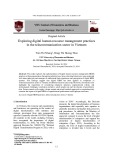
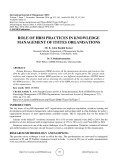
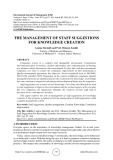
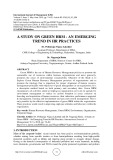
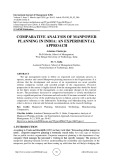
![Đề án quản lý và phát triển nhân sự tại đơn vị cấp phòng [Chuẩn SEO]](https://cdn.tailieu.vn/images/document/thumbnail/2017/20170419/msy1976/135x160/2751492583749.jpg)
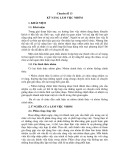

![Tài liệu đào tạo, bồi dưỡng lãnh đạo cấp phòng [Mới Nhất]](https://cdn.tailieu.vn/images/document/thumbnail/2017/20170210/nomoney3/135x160/2145657834.jpg)









![20 câu hỏi Quản lý dự án phần mềm có đáp án [mới nhất]](https://cdn.tailieu.vn/images/document/thumbnail/2025/20251003/hieu2004haha@gmail.com/135x160/78791759734259.jpg)


![Tài liệu Quản lý dự án: Kiến thức nền tảng toàn diện [chuẩn SEO]](https://cdn.tailieu.vn/images/document/thumbnail/2025/20250910/kimphuong1001/135x160/92631757496585.jpg)



